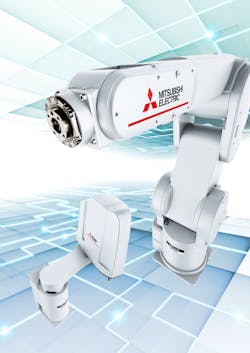Integrate robots and 3D vision to streamline bin picking
“Many manufacturers need to accommodate castings, machining processes, components with varying shapes and sizes, automotive components that come from many different suppliers, and heavy industrial parts. This makes it very difficult to place parts in trays or other orderly arrangements that can simplify pick-and-place operations,” says Ben Sagan, business development manager for robotics at Mitsubishi Electric.
Logistics companies like Amazon deal with similar situations as they package multiple, different products of all shapes and sizes for customers.
Parts in these processes are often located in bins with little order in orientation. This requires flexible robotic systems that can accommodate great variability in product size, shape and position. Combining 3D vision with robots can be the most cost-effective solution to this problem, according to Sagan.
Machine vision applications utilizing 3D imaging are a growing niche within the industry.The most commonly used imaging method is line scanning based on triangulation, which utilizes the motion of the product or image during the imaging process to identify an object’s position in 3D space.
These systems typically comprise multiple cameras mounted at different locations or one or more laser displacement sensors to triangulate the position of the object. The cameras view the line from different angles. The deviation of the line represents shape variations. Multiple scans are assembled into a data point cloud, enabling the robot to learn part shapes and orientation from different data points in space.
“Selection is made based on first available, next available and next feasible,” explains Adam Welch, product marketing manager. “Using CAD data and a series of lines in a grid pattern, the robot can be taught the points it needs to grasp. The most complex aspect of the design is the end-of-arm tooling the robot will have to use to grasp and pick up or place the part.”
A complete understanding of the parts and the process are fundamental to developing an integrated robot-3D vision system for bin picking. “This includes budget, software, the time necessary to identify and relay pick points, the current box or container you’re using and the number of different parts,” says Sagan. “You also have to understand that 3D vision is not an inspection system to identify defects; the sole goal is to identify where the part is and how to pick it up.
“Other crucial aspects of system design,” he adds, “include lighting, whether the images are to be black and white or utilize an overlay color, how far away an object is and how big a field of view the camera will need and at what defined height. The tighter the field of view, the more accurate and repeatable the process.”
Six- or seven-axis robots are the best for this type of application. They provide extra articulation and are more flexible because they can change their angle of approach, allowing them to coordinate what they see with the action they have to take.”
Mitsubishi has its own vision hardware and software, but also works with a number of third party suppliers. “We can analyze a process and recommend a vision system that delivers the best solution,” adds Welch. “That’s especially valuable for companies that don’t have a lot of experience with these applications.”
While robots integrated with 3D vision are still in their infancy in terms of adoption, most experts expect rapid growth. “It’s one of the larger hurdles automation has had to overcome, but we’re seeing better solutions all the time. Customers are demanding it,” says Sagan.

